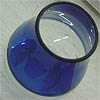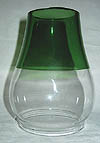Questions & Answers |
Buying & Selling |
General Information |
Reproduction Two-Color Globes
|
||||||
 |
 |
 |
 |
 |
New reproduction two-color globes are being produced for conductor's lanterns. The globes are available as custom orders and are being sold by [email no longer valid in 2014]. They can be red, green or blue over clear.
My guess is that production takes two glass tubes, one clear and one colored, fuses them, and then uses a free-blown process to achieve the desired globe dimensions. I believe that production tries to follow the globe dimensions found in many lantern books and catalogues as best as possible, but results are not exact. Shown at right from top to bottom are a conductor's lantern with a reproduction blue-over-clear globe, three closer views of the globe, and a reproduction green-over-clear globe. Click on any image for a larger version.
There are some important differences compared to genuine antique globes.
One more point on differentiation. Antique two color globes with cut glass decorations have not been reproduced to my knowledge. I am told that it takes great skill to produce the old english letters and wreath decorations on those globes. Make sure you know how to tell the difference between etched glass and cut glass (etched glass is flat and uniform, cut glass is uneven in depth and looks "cut"). It takes less skill to chemically etch a professional design on glass than to actually free-hand cut a design into glass.
For the most part, the reproduction globes are excellent and a fine substitute to the costly antique globes. I currently have a blue over clear in a A&W Queen (shown in the very top row) and the fit is very good. The unfortunate thing is that if these globes are sold unscrupulously on Ebay or sight unseen, the buyer will not be able to tell until they get the globe, so buyer beware!
Comments...
"I agree 100% but.... Precision glass cutting is not a lost art. Older style artwork as well as lettering can be done by a skilled glass cutter. I saw this recently at the antiques mall in Strasburg, Va. A lady was set up there doing some fairly impressive work. I talked with her for a while, and she said that she could do anything for a price of course.
The other point that I'd like to make is that with a computer and professional stencil cutter, any (REPEAT ANY) pattern can be reproduced in great detail. I've seen some absolutely amazing glass etchings on car windows at a local car show. If they can do it to a car window, with the prices that these things are bringing, can globes be far behind? I believe that the unscrupulous will stop at nothing.
- Ex Sou Ry